
Imagine that you’re on foot with your BOB on your back. The trip takes longer than expected and you are still miles from anyplace. Your phone finally dies, your radio goes silent, and your flashlight is getting dim.
Many folks’ BOB load-out includes a few battery-powered devices: flashlights, phones, portable radios, etc. Batteries run out. A miniature version of a solar kit can ensure that you won’t be stuck out in the dark wilderness with dead batteries.
In my last post, we explored how to set up a small solar backup system for your home. Fitting out your BOB with solar is remarkably similar — just on a miniature scale.
Functional Goals
The Get Home Bag I keep in my truck includes a few small electronic items: a couple LED flashlights, and a small AM/FM radio. (pictured below). My EDC includes my phone and a keychain flashlight.
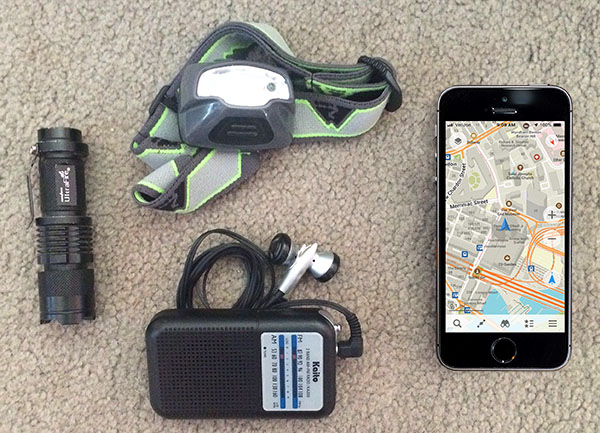
If my bug out took more than a couple days, I could use up their batteries. My phone has far more maps than I want to tote around in paper form. It also has stored reference material. Map apps are notorious for consuming battery life. I want to be able to keep my phone charged and recharge the batteries in my flashlights and radio as needed. I’ve used my little radio for news and weather on my night-in-the-woods camping ventures. It’s easy on the batteries but I want to be assured it will have juice. A backup lithium battery can help but those eventually run out too. The solution is solar.
Three Basic Parts
Just like a solar rig for your home, a Bug Out Bag’s solar kit includes:
(1) a solar panel or array,
(2) a battery in which to store your solar power, and
(3) something to use that power. (such as a battery charger of AA and AAA batteries.)
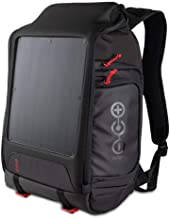
With these three components, your phone, radio, and flashlights will have renewable power. There are quite a few ready-made “solar backpacks” on the market, such as the one pictured here. Some even come with a built-in battery. There were a couple of downsides to the readymade products.
One is that the solar panel is fixed to the back. I guess they assume you will always be walking north. (?) Their 5 or 10-watta solar cells will produce some voltage in indirect light but seldom a good charge voltage.
Two is that the backpacks themselves are usually small and more like school bags. They are not what a prepper would select for his/her BOB. I wanted to keep my existing bag AND be able to move the solar cells to wherever was getting the sun, not just on my back. So, I assembled my own components.
Solar Options
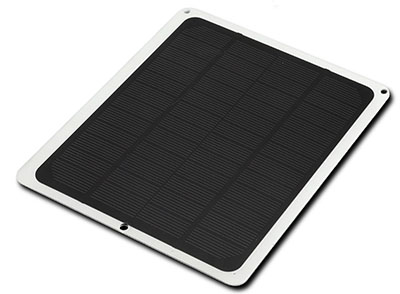
My first BOB solar panel is a 10-watt, single rigid square panel approximately 7×9”. The upside is that It is durable (laminated Lexan) and lightweight. Being only 1/8” thick, it is easy to pack, slipping in between just about anything. The downside was that it makes only 10 watts on a good day. It is more of a challenge for it to provide 1 full amp of 5 volts at the USB port. It needs more direct sun to create charge voltage. I needed something with more oomph. This panel might still become part of a “lite” kit or it might get repurposed into a solar pump for a rain barrel. I haven’t decided.
(This post contains affiliate links, btw)
My second BOB solar panel is a four-part folded array, rated at 20 watts. It is a little bulkier, though still quite packable: measuring 7 x 5 x 1” when folded up. It unfolds to be 7 x 20 inches. This panel can easily produce 1 amp at the USB port on average partly-sunny days. In strong sunlight, it can get close to 1.5 amps.
Battery Options
You need something to store the wattHours your solar panel generates. Lithium backup batteries are great. You’ve seen batteries like this, no doubt. They have one or more USB ports for both input and output. Those batteries intended for hiking or camping are usually rubberized and water-resistant.
My first BOB battery is a 5,000mA lithium cell (that’s 5 amps, btw) by Dizaul. There are many that look very similar. They have a solar cell on one side, which is largely a marketing gimmick. Such a small solar cell is really not adequate to recharge the battery in a timely way. The integral solar cell is rated at only 120 mA. That means it could take 40 hours of sun to recharge from nearly empty. Even if you got eight good hours of sun a day, that would be over five days to recharge! In my testing, it usually takes longer than that.
The reality is, the manufacturers assume that you will be recharging your battery from a USB source or the grid. In order to recharge it without the grid, I needed a bigger solar source than the built-in 120mA cell on the battery.
My second BOB battery is a 10,000mA lithium cell by BearTwo. There are many copies of this design too. It has the same little 120 mA solar panel on the front that would take over ten days of sun to recharge. I’ve placed it in a sunny window for a week and only been able to go from half-charge to three-quarters charge. Progress, but no silver-solar-bullet. Some batteries can be hungrier than others. The BearTwo also wants a stronger current to charge it than the 10-watt solar panel could provide. The 20-watt panels can. As you’ll see later, the bigger battery has its plusses and minuses.
Charging Options
I wanted something to recharge my devices’ AA and AAA batteries while I was still in the field. For that, I got a little USB battery charger that my lithium battery could power. There are several on the market. I like the one I got, but it appears to be unavailable at the moment. My second choice was this one: EBL C807. A feature I liked about both of them was that they could charge 1, 2, 3, or 4 batteries. You can mix sizes too. Some chargers require that you charge matched pairs only. My headlamp uses 3 AAA batteries. My radio uses 2 AAAs. My CREE flashlight uses 1 AA battery. Being able to charge only in matched pairs was too restrictive.
Practical Application
While traveling on foot, I would have the solar deployed wherever got the best sun: hanging off my bag, or the side, etc. It would be charging my lithium battery. Once I had ‘made camp’ at the end of a travel day, I would swap out the batteries in my radio and charge up my phone. If my flashlight batteries were low, I could swap those out too and recharge the low ones. The next day would be a repeat procedure.
Vital Battery
The solar cells do not create enough juice to drive the battery charger directly or charge up my phone — even though photos in the ads show phones plugged directly into the solar cell. The battery charger wants more power than the solar cells generate — even in full sun. The practical solution is to have the solar cells charging up the lithium battery during the day and let the lithium unit drive the USB charger and phone after dark. It can deliver the amperage the charger wants.
The same applies to my phone. It is able to charge off of the solar cells directly while the panel was making peak current. A bit off-angle or shade, however, and the phone was no longer charging. If you were bugging out, for real, you would be too busy traveling to keep fussing with whether your phone was charging or not. It is better to just let the lithium battery charge up off the solar cells and divvy up power after you make camp.
The Bigger Kit
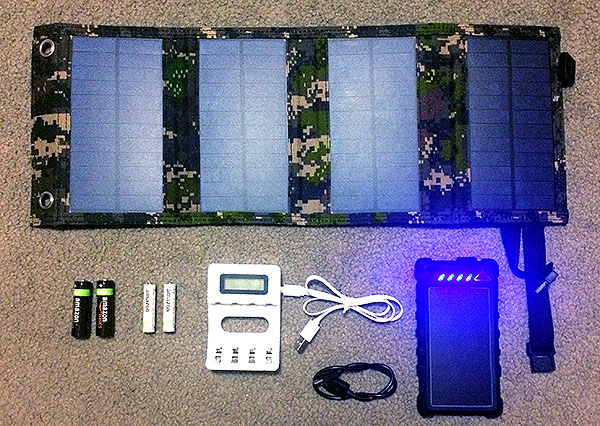
Pictured above is my bigger BOB solar kit. It includes the folding 20w solar array and the 10000mA BearTwo battery in addition to the ELB charger, cables, and batteries. This kit weighs in at 24.12 ounces (1.5 pounds)
The Lite Kit
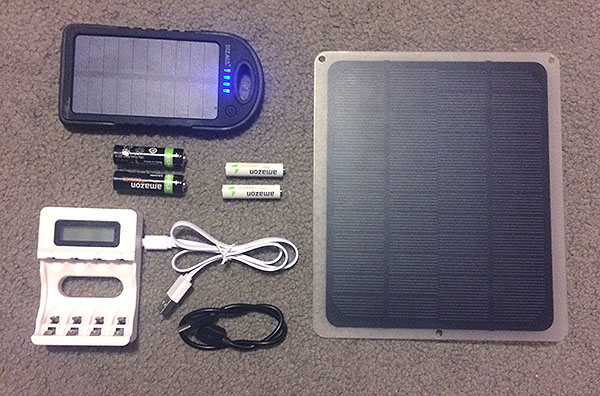
Pictured above is my “lite” kit. It includes the thin 10w solar panel and the 5000mA Dizaul battery. The ELB charger and spare batteries are the same. This “lite” kit weighs in at 17.1 oz. (1.1 lbs)
Bigger Isn’t Always Better
On the plus side, the bigger BearTwo battery can provide twice as much charging power to my phone and battery charger. The small solar panel could not seem to produce enough power to charge the bigger BearTwo battery.
Of the two batteries, the Dizaul seemed to need less solar power to charge and charged faster. The 10w panel could supply enough voltage in good sun. The 10-watt panel and 5kmA battery were more of a hand-to-mouth solution. On bright or sunny days, it worked fine.
The higher-capacity 10kmA battery allowed for more recharging or carryover for gray days. A downside of that bigger capacity is that it is a bigger bucket to refill. In practice, you probably won’t get enough sun to fully recharge either battery if you’re using it at night to replenish your phone and AAA batteries.
What About An EMP?
An electromagnetic pulse (or a CME) is just one of the possible reasons that could cause me to be trekking on foot with my Get Home Bag. If an EMP turns everything electronic into bricks, then I’ll lighten my load and press on. I have some limited paper maps and a regular compass. If, however, it is a different problem or an EMP that turns out to not be as totally devastating as is typically portrayed in many novels, I could still have functional battery-operated devices that will want to be recharged.
Conclusion
If you anticipate having to travel on foot that might stretch into two or three days, your bug out bag could benefit from a little solar. If your gear includes a radio, flashlights or a phone, it is prudent to provide a way to replenish that power — especially if things take longer than you expected. A small solar kit along the lines mentioned above can give you that renewable resource and keep you from being left in the dark.
Is your bag packed for a multi-day trek? Does it contain battery-operated devices?

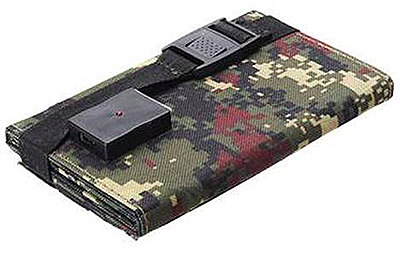
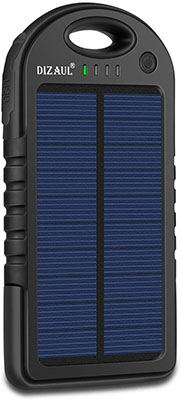
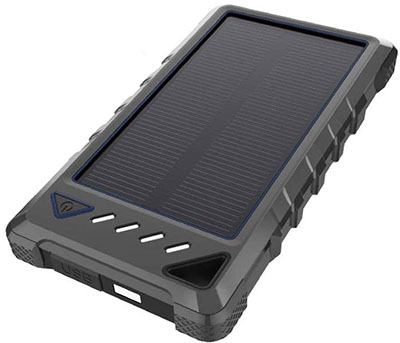
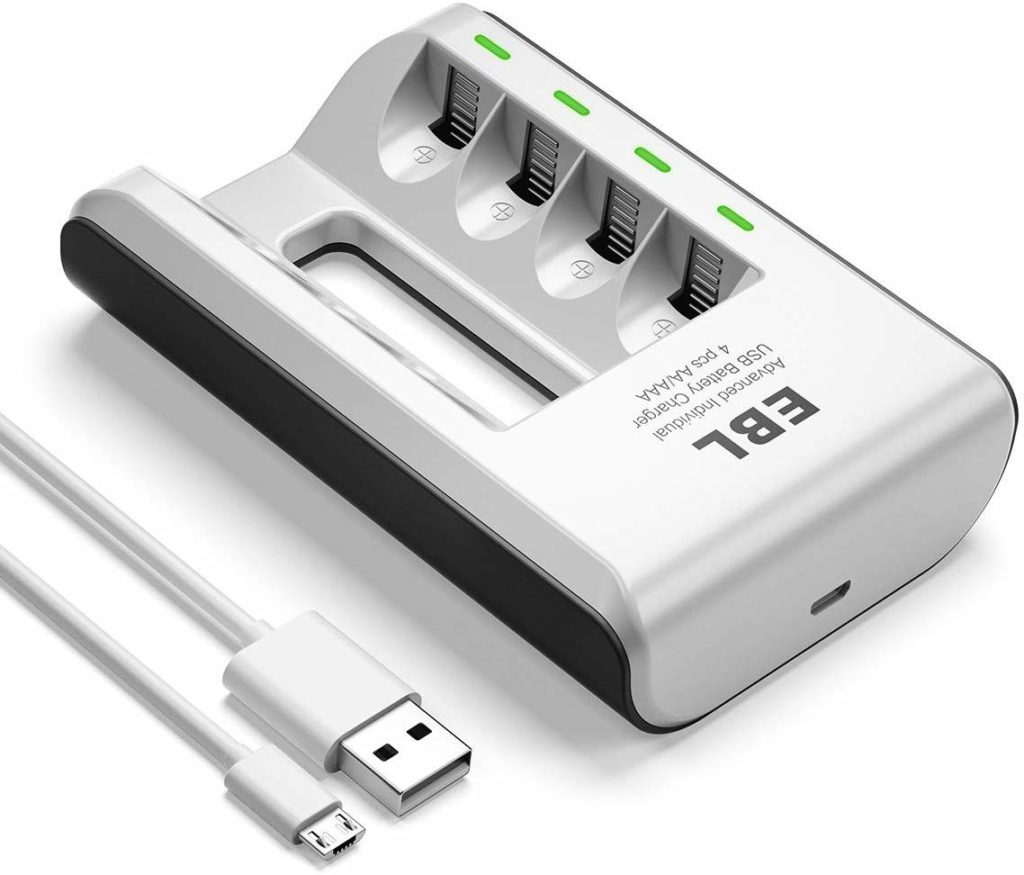
possibility of a faraday type backpack?
Hi Steve,
Interesting idea. I gather you’re thinking of the backpack as protected while in storage? If you’re bugging out because the grid is down, the EMP would have already happened.
if an EMP attack is committed, then you will likely find that it will entail multiple detonations over a span of time. once the first strike is realized many folks will reach for their protected back up electronics…which a second attack could then destroy.
HI Vocal,
I guess a multiple-EMP attack assumes it’s a major (nation) player with the resources for multiple EMP nukes. Russia, China, maybe NK, maybe Iran. Since the military ‘harden’ for EMPs, it would mostly be the civilian world that loses electronics (or power).
Such an obvious nation-state attack would probably provoke a major nuclear response — all heck breaks loose. To avoid the obvious (nation-state culprit) it seems as likely (maybe more?) that a single terrorist-style EMP nuke would be the tool of choice. Do big damage with plausible deniability.
What do you think?